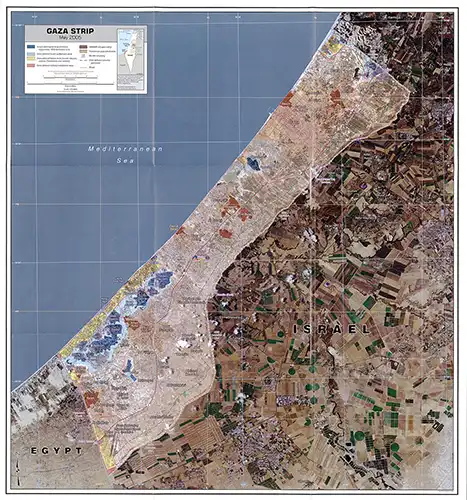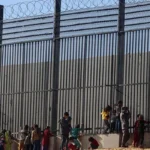“Occupation”
Year 2005
The unilateral disengagement plan proposed by Prime Minister Ariel Sharon in December 2003 called for the withdrawal of all Israeli settlements and military presence from the Gaza Strip, as well as four settlements in the northern West Bank. This decision, approved by the Israeli Government on June 6, 2004 and confirmed by the Knesset on October 26, 2004, was one of the key moments in the history of the region.
The main goals of the plan are:
- Ending the occupation of Palestinians in the Gaza Strip and strengthening Israel’s position in the international arena.
- Maintaining control over the airspace and coastal waters of Gaza after the evacuation, due to concerns about a possible resurgence of terrorism by radical Palestinian groups.
- The release of several brigades for the Israeli army to respond to potential threats from Iraq or Syria, as well as cost savings.

The beginning of Israel’s withdrawal from Gaza in August 2005 led to the evacuation of more than six thousand Israeli citizens from the region. In the context of the international peace plan known as the Road Map, which aimed to establish a Palestinian State by the end of 2005, Israel’s withdrawal from Gaza marked an important milestone. However, the establishment of a Palestinian State was not achieved due to various obstacles.
Main stages and implementation of the evacuation plan
The Unilateral Disengagement Plan proposed by Ariel Sharon set out an ambitious goal – the withdrawal of all Israeli settlements and military presence from the Gaza Strip and four settlements in the northern West Bank. The implementation of this plan took place in several stages:
- Preparatory stage:
- The Israeli authorities have developed a set of measures aimed at supporting and compensating evacuated settlers, including compensation packages that take into account “settlement experience”, property damage, family size and property values.
- Measures were taken to ensure order during the evacuation, including arrests of protesters who opposed the withdrawal of Jewish settlements.
- The main stage of evacuation:
- Israel’s withdrawal from Gaza was scheduled to begin on 15 August 2005 and end on 23 September 2005.
- Approximately 42,000 soldiers and police were involved in the process, underscoring the scale and complexity of the operation.
- The day before the evacuation began, more than 400 families voluntarily left the Gaza Strip, which led to the emptying of many towns and villages.
- Completion of the evacuation and subsequent actions:
- The authorities planned to complete the evacuation within three weeks, after which the Palestinian military would occupy the liberated settlements.
- This phase also included assessing the impact of the settler withdrawal and preparing for possible retaliatory actions by radical Palestinian groups.

Consequences and critical assessment of Israel’s withdrawal from Gaza
Following the unilateral withdrawal of Israeli settlements initiated by Prime Minister Ariel Sharon, the situation in the region has undergone significant changes:
- Territorial control: Despite the withdrawal of troops, Israel retained control over the airspace and coastal waters of Gaza, which was an important condition for ensuring the security of the State. The Gaza Strip, with a population of almost 1.4 million, has become one of the most densely populated areas on the planet.
- Political consequences: In 2007, after an armed coup, the Hamas movement seized power in Gaza, which led to the division of the Palestinian territories: Gaza under Hamas and the West Bank under the Palestinian Authority, led by Fatah.
- Economic and social challenges: Due to the aggressive policies of Hamas, the Gaza Strip has faced a blockade imposed by Israel and Egypt in 2007, resulting in high unemployment, poverty, and food insecurity. Despite the difficulties, efforts have been made to improve the situation, including the rehabilitation of housing and infrastructure, the development of the private sector and the provision of humanitarian assistance.
Long-term effects
- Israel-Gaza engagement after the withdrawal: Israel’s 2005 withdrawal from Gaza led to major changes in relations between Israel and Gaza, as well as within the region itself. Israel continued to exert significant influence in Gaza, as the region was heavily dependent on Israel for food, electricity and water supplies, which Israel provided to the entire Gaza Strip on preferential terms. Israel’s policy towards Gaza in the following years included various approaches, including a strategy of “division and silence” towards Hamas, but these measures did not lead to the elimination of the Hamas regime in Gaza.
- The role of regional powers: The future of Gaza dependssignificantly on the role that Middle Eastern countries such as Egypt, Jordan, Qatar, and Saudi Arabia should play. Israel’s relations with Gaza and other regional players should always be determined by the post-war regime in Gaza and its relations with Iran.
Implementation of the plan and implications for Israel and Palestine
Expectations and concerns:
- Unanimous opinion from experts such as Yossi Beilin, the former Israeli Justice Minister, warned that a unilateral withdrawal from Gaza could lead to more violence and strengthen Hamas.
- Ami Ayalon, a former Shin Bet security chief, expressed concern that such a move could be interpreted as Israel’s capitulation, which would strengthen extremist forces in Palestinian society.
- Eitan Ben-Eliyahu, a former commander of the Israeli Air Force, said that a unilateral withdrawal does not guarantee long-term stability and could lead to the creation of a unified state, which signals the end of the Zionist dream.
Perception by Palestinians: - Polls among Palestinians showed that most viewed Israel’s withdrawal as a victory for violence and expect similar results in the West Bank and Jerusalem.
- The Palestinian Authority and Hamas were preparing to compete over who would be perceived as the winner in Gaza, with the PA planning mass celebrations and Hamas organizing military parades.
In the end, all three opinions turned out to be right.

Thus, the “Israeli withdrawal from Gaza in 2005” led to today’s consequences. Given the freedom to choose, the Gaza Strip has focused not on self-determination and statehood, but on building up its military power to continue its confrontation with Israel. What this led to, today we can fully observe.














